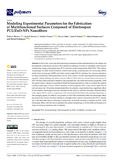Mostrar el registro sencillo del ítem
Modeling experimental parameters for the fabrication of multifunctional surfaces composed of electrospun pcl/zno-nps nanofibers
| dc.creator | Rivero Fuente, Pedro J. | es_ES |
| dc.creator | Fuertes Bonel, Juan Pablo | es_ES |
| dc.creator | Vicente Gómara, Adrián | es_ES |
| dc.creator | Mata Ruiz, Álvaro | es_ES |
| dc.creator | Palacio, José F. | es_ES |
| dc.creator | Monteserín, María | es_ES |
| dc.creator | Rodríguez Trías, Rafael | es_ES |
| dc.date.accessioned | 2022-04-12T08:44:49Z | |
| dc.date.available | 2022-04-12T08:44:49Z | |
| dc.date.issued | 2021 | |
| dc.identifier.issn | 2073-4360 | |
| dc.identifier.uri | https://hdl.handle.net/2454/42734 | |
| dc.description.abstract | In this work, a one-step electrospinning technique has been implemented for the design and development of functional surfaces with a desired morphology in terms of wettability and corrosion resistance by using polycaprolactone (PCL) and zinc oxide nanoparticles (ZnO NPs). The surface morphology has been characterized by confocal microscopy, scanning electron microscopy (SEM), atomic force microscopy (AFM) and water contact angle (WCA), whereas the corrosion resistance has been evaluated by Tafel polarization curves. Strict control over the input operational parameters (applied voltage, feeding rate, distance tip to collector), PCL solution concentration and amount of ZnO NPs have been analyzed in depth by showing their key role in the final surface properties. With this goal in mind, a design of experiment (DoE) has been performed in order to evaluate the optimal coating morphology in terms of fiber diameter, surface roughness (Ra), water contact angle (WCA) and corrosion rate. It has been demonstrated that the solution concentration has a significant effect on the resultant electrospun structure obtained on the collector with the formation of beaded fibers with a higher WCA value in comparison with uniform bead-free fibers (dry polymer deposition or fiber-merging aspect). In addition, the presence of ZnO NPs distributed within the electrospun fibers also plays a key role in corrosion resistance, although it also leads to a decrease in the WCA. Finally, this is the first time that an exhaustive analysis by using DoE has been evaluated for PCL/ZnO electrospun fibers with the aim to optimize the surface morphology with the better performance in terms of corrosion resistance and wettability. | en |
| dc.description.sponsorship | Project RTI2018-096262-B-C41–MAITAI, funded by MCIN/AEI/10.13039/501100011033 and, as appropriate, by ERDF 'A way of making Europe'. Grant PRE2019-090656, funded by MCIN/AEI/10.13039/501100011033 and, as appropriate, by ESF 'Investing in your future'. Project PJUPNA1929 funded by MCIN/AEI/10.13039/501100011033 and, as appropriate, by ERDF 'A way of making Europe' and by BEI. | en |
| dc.format.extent | 19 p. | |
| dc.format.mimetype | application/pdf | en |
| dc.format.mimetype | application/zip | en |
| dc.language.iso | eng | en |
| dc.publisher | MDPI | en |
| dc.relation.ispartof | Polymers, 2021, 13, 4312 | en |
| dc.rights | © 2021 by the authors. Licensee MDPI, Basel, Switzerland. This article is an open access article distributed under the terms and conditions of the Creative Commons Attribution (CC BY) license. | en |
| dc.rights.uri | http://creativecommons.org/licenses/by/4.0/ | |
| dc.subject | Corrosion rate | en |
| dc.subject | DoE | en |
| dc.subject | Electrospinning | en |
| dc.subject | PCL | en |
| dc.subject | Wettability | en |
| dc.subject | ZnO nanoparticles | en |
| dc.title | Modeling experimental parameters for the fabrication of multifunctional surfaces composed of electrospun pcl/zno-nps nanofibers | en |
| dc.type | info:eu-repo/semantics/article | en |
| dc.type | Artículo / Artikulua | es |
| dc.contributor.department | Institute for Advanced Materials - INAMAT | es_ES |
| dc.contributor.department | Ingeniería | es_ES |
| dc.contributor.department | Ingeniaritza | eu |
| dc.rights.accessRights | info:eu-repo/semantics/openAccess | en |
| dc.rights.accessRights | Acceso abierto / Sarbide irekia | es |
| dc.identifier.doi | 10.3390/polym13244312 | |
| dc.relation.projectID | info:eu-repo/grantAgreement/AEI/Plan Estatal de Investigación Científica y Técnica y de Innovación 2017-2020/RTI2018-096262-B-C41/ES/ | en |
| dc.relation.publisherversion | https://doi.org/10.3390/polym13244312 | |
| dc.type.version | info:eu-repo/semantics/publishedVersion | en |
| dc.type.version | Versión publicada / Argitaratu den bertsioa | es |
| dc.contributor.funder | Universidad Pública de Navarra / Nafarroako Unibertsitate Publikoa, PJUPNA1929 | es |



